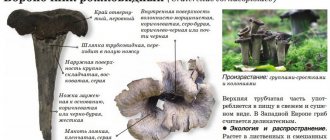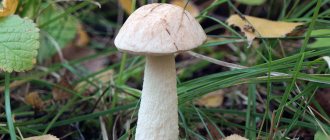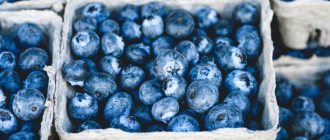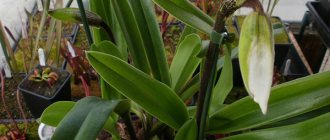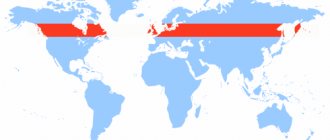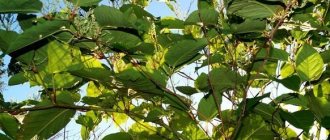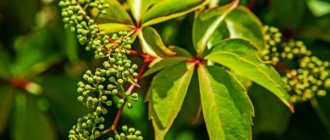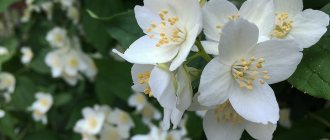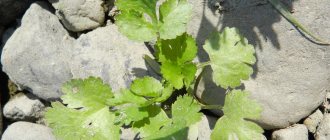The porcini mushroom (lat. Boletus edulis) represents the most respected mushroom genus - boletus. If earlier he was called the “king of mushrooms,” today we can say about him that he is the undisputed leader of the mushroom rating. This hero has unparalleled taste. It is difficult to confuse the porcini mushroom with its doubles and inedible analogues - it is so beautiful and unique. Boletus is the most desired trophy of a mushroom picker.
Features of porcini mushroom
Any type of boletus has a special mushroom aroma and piquant taste. They all have similar shapes, the differences are only in small details. Description of the external data of the most common variety of boletus - spruce (Boletus edulis):
- Hat . Color – brownish-brown. Diameter up to 30 cm. In some latitudes they can grow up to 50 cm. The upper skin is tightly adherent to the pulp. In drought it cracks, in rain it becomes covered with mucus.
- Leg. Thick, massive, up to 20 cm high. Thick – up to 5 cm. Shape – cylindrical or club-shaped. Expands towards the base. Color – white, light brown. There is a mesh pattern on the leg. Deeply buried in the soil. There are no traces of a blanket on the leg - boletus mushrooms do not have a “skirt”, the leg is perfectly clean.
- Pulp. In mature individuals it differs in density. Very juicy, white, fleshy, arouses appetite just by its appearance. When overripe, it has a fibrous structure and the color becomes yellowish or beige.
- Tubular body. First white, then yellowish. Older specimens have a greenish appearance.
- Controversy. Olive-brown powder. Size – 15.5 x 5.5 microns.
To determine the age of the mushroom, examine the cap - in young people it is convex, in old people it is flat. With age, its color darkens. Old mushrooms are not suitable for food.
The taste of boletus mushrooms is characterized by the softness of the pulp and the delicacy of the aroma. Heat treatment and drying only enhance the taste.
Growing porcini mushrooms in a personal plot: planting mycelium
In the photo, growing porcini mushrooms on a personal plot
There are several ways to plant porcini mushroom mycelium. In the first method, overripe porcini mushrooms are collected and filled with rainwater in a wooden bowl. This mixture is left for a day. Then mix well and filter through a fine cloth. As a result of this procedure, a lot of porcini mushroom spores remain in the water. They settle to the bottom. To germinate them, you can add a little baker's yeast to the water. Then carefully remove the foam with a spoon and drain the upper part of the clear liquid, and place the remaining part of the solution with spores in the light. You can drain the remaining liquids from different containers into one. After a week, the upper part of the clear liquid is carefully drained, and the settled suspension is poured into bottles and stored in the refrigerator. This suspension can be used for a whole year, but it is better to use it during the first month, since it is during this time that the spores retain their viability. Water the prepared bed with this mixture, and first remove the top layer of soil.
You can also water the mixture around the selected trees. First, carefully remove the layer of soil without damaging the tree roots. This is done in order to expose the roots of the trees. Then water them with the suspension and cover them again with earth. Pour the suspension at the rate of 400 g for every 30 cm2. After which the soil should be watered generously with 4–5 buckets of water.
In the second method of growing porcini mushrooms in the country, the mycelium is harvested in places where porcini mushrooms grow. Why, around the mushroom, layers of soil measuring 20 X 30 cm and a thickness of 10–15 cm are cut out. Then they are cut into several parts and planted in a bed or in a chosen place so that there is a layer of earth 5–7 cm thick above them. The beds are then moisten a little and cover with leaves and shields so that they are always moist.
Porcini mushrooms should be sown under the same trees under which the planting material was taken. It has been noticed that boletus mushrooms grow better under trees that are 15–25 years old.
You can sow mycelium in another way. Why overripe porcini mushroom caps are cut into small pieces and mixed with a small amount of soil. Then moisten it a little. You can also sow slightly dried mushroom caps. They are laid out on a bed and watered with water. After 5-6 days they are removed - the spores along with water have already penetrated into the soil. You can place pieces of the cap under the top layer of soil.
It is better to sow mycelium in September.
- Author: admin
Rate this article:
- 5
- 4
- 3
- 2
- 1
(2 votes, average: 5 out of 5)
Share with your friends!
When and where does it grow?
The distribution range of boletus mushrooms is amazing - they are found on almost all continents. The exceptions are Antarctica and Australia. Japan, Mexico, Mongolia, North Africa, the Caucasus - boletus grows everywhere. You won't find it except in Iceland. In Russia it grows almost everywhere - from the southern latitudes to Kamchatka. The spruce boletus is found in spruce and fir forests.
Each area has its own fruiting time. In warm zones, the mushroom begins to grow in May-June, and bears fruit until October-November. In the north, the growth period is from June to September. It has a long growth phase - it needs to grow for a whole week to reach maturity. Grows in families, rings. Having discovered one specimen, you need to carefully explore the nearby space - there will probably be several more there.
Prefers to grow in forests:
- conifers;
- deciduous;
- mixed.
It grows most often under spruce, fir, pine, oak and birch trees. Where to look for them:
- in places overgrown with lichen and moss;
- loves old forests;
- It can grow in the shade, but the sun doesn’t bother it either – it prefers warm areas.
It doesn't grow:
- in wetlands;
- in peat bogs.
The best weather for massive growth of boletus mushrooms is passing thunderstorms, warm nights and fogs.
Rarely found in forest-tundra and steppe. His favorite soils:
- sandy;
- sandy loam;
- loamy.
Mushroom pickers tell how to find boletus mushrooms in forest-steppe conditions. They will reveal to you the secrets of mass collection, and where porcini mushrooms are hidden:
Where porcini mushrooms grow: in which forests can boletus mushrooms be found?
In the forests where porcini mushrooms grow, the soils are predominantly sandy, but boletus mushrooms can also be found on fertile soils. More often found under birches, less often under oaks, prefers mature trees over 20 years old. It lives in the temperate and subarctic zones throughout Eurasia.
Porcini mushrooms grow from the second half of June to the end of October, but in hot weather they begin to bear fruit in May, although the largest number of mushrooms is observed in the forest from mid-July to the very end of August. In the summer months, boletus mushrooms grow singly, and in the fall - in small groups.
You can find porcini mushrooms where the forests are at least 50 years old; it is useless to look for them in young forests. Boletus mushrooms can also be found singly, but more often in groups, so when you find one mushroom, you need to look around carefully - there are probably several more growing nearby. Porcini mushrooms grow in sparse places, warm and well-lit, on the edges, clearings, forest clearings, often where there are many forest anthills. The best time to collect porcini mushrooms, when they appear en masse, is during the heading of cereals, although individual mushrooms can be found until late autumn. Depending on the places in which porcini mushrooms grow, there are four varieties: birch, spruce, pine and oak.
Varieties
Boletus mushrooms grow everywhere in the forests of Russia, and there are a great variety of them. It is clear that they are all from the same family. They are distinguished only by the nuances of their appearance. All belong to the first taste category, each has an inedible double. Therefore, when starting a “silent hunt”, carefully study the external signs of those mushrooms that are found in your area.
Pine
Its external characteristics practically repeat the general description of boletus mushrooms. What are the differences:
- The cap is red-brown with a diameter of 8-25 cm. Shade – purple.
- Pulp. Under the skin it is pink.
- The leg is very thick, short - up to 15 cm. On top there is a light brown mesh.
- The thickness of the tubular body is 2 cm. The shade is yellowish.
It has an early form, characterized by a lighter cap and flesh. Growth begins at the end of spring and continues until October. It settles under pine trees - hence the name. With them it forms mycorrhiza - a fungal root. Found on sandstones, alone and in families. Distribution area: Europe, America, the European part of Russia.
Birch
Its second name is spikelet. It is collected when earing of rye fields begins. Distinctive features:
- The hat is light yellow, with a diameter of 5-15 cm. The flesh does not have a distinct taste. It does not darken at the break.
- The leg is barrel-shaped, with a light mesh.
- The thickness of the tubular layer is 2.5 cm. The shade is yellowish.
Prefers to grow under birch trees. They grow singly and in groups. Favorite places are on the edges, near roads. Distribution area: Western Europe, Siberia, Far East. Collection season is June-October.
Dark bronze
Hornbeam or copper. Species differences:
- Round, fleshy cap with a diameter of 7-17 cm. Dark shades. It may be covered with cracks.
- The pulp is white. With a pleasant aroma and taste. In the rift the color changes.
- It is distinguished by a massive leg - it is pinkish-brown. Covered with brown mesh.
- A tubular layer 2 cm thick. Yellow in color, turns green when pressed.
Fans of edible delicacies value hornbeam boletus more than the “classic” porcini mushroom (spruce).
Grows in deciduous forests in warm climates. Distribution: Europe, North America.
Other varieties
There are also the following varieties of porcini mushroom:
- Reticulate. It has a brownish or light ocher cap. The leg is short, cylindrical in shape. Can be confused with moss fly. Prefers beeches and hornbeams. Grows in Europe, North Africa and North America. It has a pronounced mesh on the leg. Fruiting time is June-September. Rarely seen.
- Oak. The hat is grayish in color. Sometimes there are light spots on it. It differs from other boletus mushrooms in its more loose pulp. Prefers oak groves. Habitat: Caucasus, Primorsky Territory. It has a brown cap, very similar to the gall mushroom.
- Semi-white mushroom. The color of the cap is light brown or clayey. The flesh is dense and smells like carbolic acid. Distribution area: Carpathian region, Polesie, southern Russia. There is no mesh pattern on the leg. The hat is light brown.
White mushroom reticulate
White oak mushroom
Semi-white type of porcini mushroom
Boletus reticulum and semi-white
The reticulated type of porcini mushrooms is distinguished by a lighter shade of the cap. It grows up to 30 cm in diameter. The flesh of the cap is fleshy and quite white. The leg is not long, club-shaped. It is distinguished by a rich brown hue and a pronounced retina.
When cut, this type of boletus exudes a pleasant aroma. Old reticulated mushrooms are distinguished by the presence of small cracks on the cap. This boletus prefers to grow on dry alkaline soils.
The semi-white or yellow boletus has a cap with smooth skin. It grows up to 15 cm in diameter. The pulp is quite dense, light yellow in color. It tastes sweetish with an odor reminiscent of carbolic acid.
The stem of the semi-white mushroom is thick, but not high. Its maximum length is about 15 cm. The tubular layer does not exceed 3 cm. Such mushrooms appear from May until mid-autumn.
To collect tasty and healthy varieties of boletus, you need to clearly know how they differ. This will protect yourself from dangerous specimens that can cause harm to the body.
Who can be confused with?
Boletus mushroom is usually confused with gall fungus (false boletus mushroom). Signs by which they can be recognized:
- According to the color of the cut. In the gall fungus, the flesh becomes dark, acquiring a pinkish-brown color. The porcini mushroom has white flesh and does not change color.
- The stem of the gall mushroom has a bright pinkish mesh; in a real boletus it is white or yellow.
- The gall mushroom is bitter. The bitterness does not disappear even after cooking. But during pickling, if you add vinegar, it decreases.
Gall mushroom (gorchak) is a poisonous false porcini mushroom.
The porcini mushroom has another double - the satanic mushroom. But with it, confusion occurs less often. Experienced mushroom pickers immediately see the difference, and it is significant:
- The color of the cap of the double is whitish to olive-gray.
- The flesh at the break immediately becomes reddish or bluish.
- The leg is covered with a mesh pattern. Its color is the main sign of a satanic mushroom. It is red-yellow on top, red-orange in the middle, and yellow-brown below. It's hard not to notice the difference!
Poisonous twin of boletus - satanic mushroom
Description of the royal and oak boletus
The oak mushroom is easily recognized by its brown-gray cap, which is darker than that of the boletus mushrooms that live near birch trees. The pulp is not as dense as other varieties. Found in the Primorsky Territory, in the Caucasus region. It grows in large “families”, which is not very typical for porcini mushrooms. The oak species is collected from June to mid-autumn.
The porcini mushroom is easily confused with the similar gall mushroom, which is inedible and has a pronounced bitter taste. In the gall fungus, the leg is covered with a darker “web”, and the tubular layer turns pink when broken.
Royal boletuses have a pink or almost red cap. The leg is a rich yellow shade, covered with a thin mesh closer to the cap. It grows up to 15 cm. The top is covered with a smooth peel that cracks.
When broken, the dense pulp changes color to bluish. Royal mushroom is delicious and incredibly aromatic. Its leg is quite thick, from 5 to 15 cm.
This type of boletus likes to live under deciduous trees on soils that have a lot of sand or limestone. It is collected in the Far East, as well as in the Caucasus. Royal mushroom is perfect for canning and drying. It is also consumed raw. Boletus mushrooms are collected from mid-summer until September.
The value and benefits of the mushroom
Boletus is the most valuable food product. The calorie content of raw boletus is 22 kcal per 100 g. Ingredients:
- proteins – 3.1 g;
- carbohydrates – 3.3 g;
- fats – 0.3 g;
- dietary fiber – 1 g;
- water – 92.45 g;
- ash – 0.85 g.
Boletus mushrooms are simply a storehouse of all possible vitamins, minerals and other useful substances. This is a valuable product that combines taste and beneficial properties. Porcini mushrooms contain everything the body needs, including:
- Selenium. There is so much of it in the pulp that consumption of mushrooms can resist cancer in the early stages.
- Ascorbic acid – normalizes the functioning of all organs.
- Calcium, iron, phosphorus and other vital elements.
- Phytohormones – eliminate inflammation.
- B vitamins - strengthen the nervous system, help normalize energy metabolism, improve memory and sleep, prevent infections, increase mood and appetite.
- Riboflavin – normalizes the functioning of the thyroid gland, promotes hair and nail growth.
- Lecithin is useful for patients with atherosclerosis and anemia. Clears blood vessels of cholesterol.
- B-glucan is an antioxidant that protects the immune system, saves the body from fungi, viruses, and bacteria.
- Ergothioneine - renews cells, restores the liver and kidneys, is beneficial to the bone marrow, improves vision.
Spruce boletus or Spruce boletus
Boletus Spruce
Appearance
The hat is up to 35 cm in diameter, initially convex, then prostrate. The skin on it can be smooth and wrinkled; in dry weather, cracks can appear on it, and in rains it becomes slimy. The edges of the cap have a fibrous-scaly structure, and its color varies from white to dark brown, with possible yellow or reddish hues. The edges are often painted in lighter shades than the center, and a light rim on the cap may be noticeable.
The hymenophore is tubular, tubes with small pores, initially white, later turning yellow.
The leg is massive and smooth, up to 25 cm long and up to 8 cm in diameter, barrel-shaped, light brown in color with a characteristic light mesh.
The pulp is dense and strong, white, does not change color when cut, but turns yellow as it ages.
Where and when does it grow
It grows from May to the end of October in coniferous, mixed and deciduous forests. Despite the name, it can form mycorrhiza not only with spruce and pine, but also with deciduous trees, including birch and oak.
Harm
Boletus mushrooms contain chitin, which is difficult to digest. It can damage:
- children;
- pregnant women;
- people with kidney disease and gastrointestinal diseases.
Porcini mushrooms are capable of absorbing harmful substances from the environment. Do not collect them near businesses and industrial areas.
Boletus spores, like other mushrooms, can cause negative reactions in allergy sufferers. The main danger is eating its double - the gall fungus. Therefore, you need to carefully study the signs of this inedible species.
Beautiful Boletus Caloboletus Calopus
A mushroom from the genus Kalobolet, family Boletaceae, also known as Boletus Inedible.
Boletus Beautiful
Appearance
The cap is up to 15 cm in diameter, initially semicircular, then convex, with a wavy and tucked edge. Painted in light brown or brownish-gray shades.
The hymenophore is tubular-type, the tubes have small rounded pores and are colored in grayish or lemon-yellow shades. They turn blue when pressed. The spore powder is brownish-olive.
The leg is up to 15 cm high and up to 4 cm thick, cylindrical or club-shaped. It has several tiers of coloring - at the base of the leg it is white, then brown-red, in the central part it is carmine red, with a noticeable reddish mesh, in the upper part it is lemon yellow, with a fine white mesh.
The flesh is dense and firm, light cream in color, turning blue when cut in the cap and the upper part of the stem. It has no distinct odor and is very bitter in taste, and this bitterness does not immediately appear on the tongue.
Where and when does it grow
It bears fruit from July to October under spruce trees, in coniferous and mixed forests, most often under spruce trees.
Can it be eaten?
The mushroom is considered inedible due to its extremely bitter taste. If it accidentally gets into the pan along with ordinary boletus mushrooms, it will spoil the entire dish with bitterness. Data on the presence of toxins in this mushroom have not yet been precisely confirmed, but there is information about cases of severe poisoning due to accidental consumption of this mushroom.
How to distinguish from Borovik
This mushroom is easy to distinguish by the “multi-tiered” color of the stem and the red mesh on it.
Use in food
Porcini mushroom is a low-calorie food product. Suitable for cooking, frying, drying, stewing, pickling. The cooked pulp is tender and has a mushroom smell.
Eating porcini mushrooms in dried form allows the body to absorb up to 80% of proteins. Nutritionists advise eating dried boletus mushrooms.
Dried porcini mushrooms have the strongest aroma, dried using the correct technology - it is important that the pulp loses moisture gradually. Mushrooms are considered a difficult food to digest. But it is dried boletus mushrooms that are the most easily digestible mushroom product.
Oak Boletus or Reticulated Boletus Reticulatus
In terms of culinary use, it is one of the most delicious types of boletus, especially fragrant when dried.
Oak Boletus
Appearance
The cap is up to 30 cm in diameter, initially spherical, then convex or cushion-shaped. The skin has a slightly velvety structure; in adult specimens, in dry weather, it may become covered with cracks.
The color of the cap is highly variable, but usually in light shades - ocher, leathery brown, grayish brown or coffee brown.
The hymenophore is tubular, the tubes are loose and thin, white in young specimens, later yellow or olive green. Spore powder is olive-brown.
The leg is up to 25 cm high and up to 7 cm in diameter, initially club-shaped or cylindrically club-shaped, later becoming cylindrical. The leg is painted in light walnut shades and covered with a characteristic brownish or white mesh.
The pulp is dense, with a sweetish taste and a pleasant mushroom smell. As it ages, the flesh becomes a little spongy.
Where and when does it grow
This mushroom prefers warm climates, hilly and mountainous areas. It grows from May to October in deciduous forests, most often in the company of beech, oak, linden and hornbeam. In southern Russia it is often found with edible chestnuts.
Growing
Porcini mushroom, despite its unsurpassed taste, is not grown on an industrial scale - it is unprofitable. Usually, amateur gardeners are engaged in cultivation. There must be coniferous or deciduous trees on the personal plot. There should be no fruit trees, cultivated shrubs or vegetables nearby. The most difficult thing in growing boletus is creating conditions for the successful creation of connections between tree roots and mycelium.
It is desirable that the site is adjacent to the forest. If this is not possible, you need to have at least a few pine, aspen, birch, oak or spruce trees on your future “plantation.” Trees on the site must be at least 8 years old. There are two ways to grow porcini mushrooms – from mycelium and from caps.
Growing from mycelium
Cultivation begins with the purchase of planting material. You need to buy mycelium in specialized stores. Next, prepare the area and plant the mycelium:
- The soil is exposed near the trunks. The top layer is removed - approximately 20 cm. The diameter of the circle should be approximately 1-1.5 m. The removed soil is saved - it will be needed to cover the crops.
- A layer of peat is applied to the area prepared for planting. Rotted compost can be used. The fertile layer should not be thicker than 2-3 cm.
- Mycelium is placed on top. The interval between adjacent pieces is approximately 30 cm. The pieces are laid out in a checkerboard pattern.
- The mycelium is covered with previously removed soil. Water generously. You need to pour about 3 buckets of water under one tree. Pour carefully so that the soil does not erode.
- Next, mulch the watered soil with straw. The thickness of the layer is 30 cm. This is done to maintain the required humidity - so that the mycelium does not dry out. Crops need to be watered weekly. Be sure to add nutritious fertilizer to the water.
Before frost, areas with mushrooms are covered. For insulation you can use moss, spruce spruce branches, fallen leaves. With the arrival of spring, the insulation is raked using a rake.
A year will pass and the first fungi will be removed. If you properly care for the mycelium, water and feed it on time, the mushroom “plantation” will bear fruit for up to 5 years.
Growing from caps
To implement this method, you will need to get a few mushroom caps. Find mature, or better yet, overripe boletus mushrooms in the forest. The diameter of the cap should be at least 10 cm. It is best that when broken, the cap has a greenish tint - this indicates the maturity of the spores.
When collecting caps, you need to remember what trees the mushrooms grew under. It will be necessary to sow spores under the same trees. If a boletus is found under a spruce, it is unlikely that it will take root under a birch or aspen.
The procedure for preparing the site and planting seed:
- About a dozen caps are soaked in a bucket of water. It is advisable that the water be rainwater. Add one thing per 10 liters:
- alcohol – 3-5 tbsp. l.;
or sugar – 15-20 g.
- After 24 hours, you should mash the boletus caps. Knead until you get a mass similar to jelly. After straining it through cheesecloth, the water is separated from the mushroom tissue with spores.
- Prepare a place for planting - exactly as in the previous version. But be sure to water peat or compost with tannins for disinfection. To prepare the solution take:
- black tea – 100 g;
or oak bark - 30 g.
- Next, they begin planting - water containing boletus spores is poured onto the prepared fertile layer. The solution is stirred while pouring. The crushed caps are placed on top, the planting is covered with previously removed soil, and covered with straw.
Mushrooms should be soaked no later than 10 hours after collection - otherwise they will spoil.
Tea is brewed in 1 liter of boiling water. The second option is to boil oak bark for 1 hour. Water the soil with the cooled solution - 3 liters for each tree.
Boletus mushrooms can reach a yield of up to 250 kg per 1 hectare. Under each tree, during the season, you can collect a bucket of porcini mushrooms.
All that remains is to take care of the crops - water them regularly, sparing no water. If the soil dries out, the mycelium will die before it has time to germinate. For the winter, the area is insulated with spruce branches or leaves. In the spring - they rake. The first mushrooms will appear next summer or autumn.
Growing indoors
You can grow boletus indoors:
- First, the premises are sterilized with a 1% chlorine solution - it kills mold and parasites.
- Creates warm and humid conditions. Place barrels of water or put wet sawdust.
- Prepare a substrate with mycelium. They put it in bags. They make cuts.
- The bags are placed at intervals of 5 cm.
- The temperature is maintained at +23-25 °C, no more. Excess will destroy mycelium.
Boletus deservedly received its royal status - it surpasses all known mushrooms in taste and health. If it is not possible to find a sufficient number of boletus mushrooms in nature, they can be grown artificially.
0
0
Copy link
How to plant and how to grow porcini mushrooms in a country house or garden plot (with video)
Boletus has always been considered the king of all mushrooms. It is quite difficult to grow it, since it belongs to the group of mycorrhizal fungi that grow in symbiosis with tree roots. Therefore, the conditions for growing porcini mushrooms should be similar to the conditions under which they live in the wild.
In the photo there are porcini mushrooms in the country
In the photo there are porcini mushrooms in the garden plot
Mushrooms love moderately moist and bright clearings, but not in the open rays of the sun. Boletus will not grow in dark places. Also, the porcini mushroom does not tolerate proximity to some herbs, such as fern and hoofweed. Before growing porcini mushrooms on your property, all these factors should be taken into account.
If you have the appropriate trees in your garden plot, then you can quite easily organize the cultivation of porcini mushroom on a production scale. No one has yet managed to grow this mushroom under artificial conditions, without trees.
Before planting porcini mushrooms in the country, you need to prepare special beds. To do this, a pit 2 m wide and 30 cm deep is dug at the selected site. It is filled with a special mixture, which is prepared in advance. Fallen oak leaves are collected in the spring and mixed with rotten oak wood and clean horse manure. Both oak wood and horse manure should be added to the leaves in a ratio of 5% of their volume. First, lay the leaves in a layer of about 20 cm, sprinkle in a little horse manure and rotten wood and water with a 1% solution of ammonium nitrate.
Then exactly the same new layer is laid. In this way, several layers are performed. After 7-10 days, the mixture should warm up to 40 °C. At this moment it must be mixed so that it becomes a homogeneous mass. After a month, the mixture is ready and it is placed in a pit in the form of layers 10–12 cm thick. Each layer is sprinkled with a layer of garden soil 6–8 cm thick. The entire thickness of the bed is about 50 cm. In the middle it is made higher so that water rolls off it.
When growing porcini mushrooms in a personal plot, the mycelium should not be overfilled with water, it may die; but in dry autumn it should be moistened with a watering can or sprayer. Growing and caring for mycelium involves periodic watering during dry summers. It is advisable to water early in the morning. There is no need to apply mineral fertilizers. Single mushrooms appear the next year after planting, and a good harvest is harvested 2 years after sowing. Under one tree you can get a bucket of harvest. When picking mushrooms, they should be carefully cut off, leaving the remains of the stem so as not to damage the mycelium.
This video demonstrates how to grow porcini mushrooms in the country:
